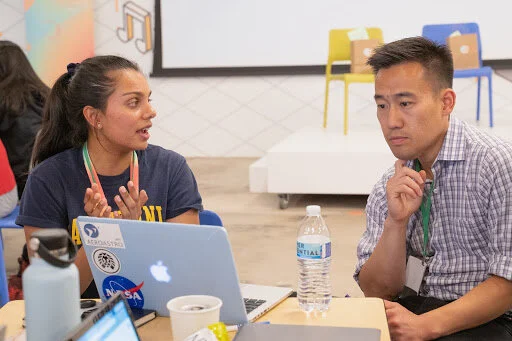Many entrepreneurs work 24-7 to get their ventures off the ground, forgoing sleep, exercise, a balanced diet, and a social life. This is one aspect of the entrepreneurial life that we don’t want our high school students to emulate. But bringing a new venture to fruition is time-consuming—even if you don’t let it consume your entire life—and there is never enough time in a high school class, after-school program, or camp to do all of the product development, customer discovery, and sales initiatives we want to do—not to mention preparing for pitch competitions!
Read MoreAs a teacher/coach who is not a well-endowed angel investor, how can you help students get the seed funding they need to realize their entrepreneurial visions? And once they do get money, what do we need to teach them about banking, cash flow, and records?
Read MoreWorking with a mentor can dramatically enhance your students’ experience, but, like any relationship, it takes work. Here’s how to make it work:
Read MoreThis spring and summer, while educators nationwide are scrambling to create meaningful learning experiences for our students online, let’s embrace best practices for fostering our future entrepreneurs in the virtual world. Let’s be ready to launch new ventures when “shelter in place” is over (or even before!)
Read MoreSales may be the most challenging aspect of “talking to strangers”—something that’s already difficult for most teenagers. But once they’ve done it a few times, it’s much less intimidating. Best of all, students who have learned “how to sell” will have an advantage when they need to sell themselves to investors, colleges and employers. This is not just about creating entrepreneurs; it’s about building skills for life.
Read MoreOnly by launching their ventures can students find out if their ideas are viable, if there’s a product-market fit, if there are revenue streams, and if those revenues will cover the costs of production. Only by launching can they learn about sales, managing stress, and teamwork. And it’s only by launching do they risk failure, which is one of our most effective learning experiences.
Read More“Fail fast!” sounds hip and catchy to innovative adults, but to most students it just sounds scary. When we emphasize creativity, experimenting with new ideas, testing our ideas in the market, and not knowing what will happen, that sounds exciting. If you tell me: You’re probably going to fail and that’s OK, I’m wary. But if you tell me: Let’s try to do something cool, and if it doesn’t work out, no big deal, I’m intrigued. It’s a small semantic shift, but it’s important.
Read MoreIn last week’s post, I shared strategies for helping student entrepreneurs learn to talk to strangers. That post was mostly about building confidence and self-awareness, so that our teenagers are not intimidated by the Customer Discovery process—and even learn to enjoy it. This week I want to tackle another aspect of talking to strangers: Teaching students the ability to adapt and adjust during conversations with adults.
Read MoreIn the Lean Startup process, student entrepreneurs are expected to talk to strangers—both teenagers and adults—not once or twice, but over and over again…
Read MoreFor many high school students, working on group projects is torture. It always seems to go one of three ways…It’s no wonder students object when we ask them to work on teams for their entrepreneurial ventures. It’s so tempting, as the teacher, just to let them fly solo…
Read MoreSo, your students have identified a meaningful problem. They’ve validated it with customer interviews. And they believe there’s a solid market for a solution.
Good news! They are finally ready to develop their minimum viable produce—aka their first iteration of a real product or service.
As the teacher/coach/advisor, you’re excited to see what they come up with. Finally, it’s getting real! But then they propose their idea, and your heart sinks because you’re pretty sure their idea is a bad idea.
Read MoreAfter an entrepreneur has invented something cool—like the Keurig coffee maker, the car cup holder, the Yeti mug, or Uber—it seems impossible that no one had thought of it before. Didn’t we realize how much leftover coffee was getting wasted in large carafes? Didn’t we spill all over ourselves while driving? didn’t we complain about taxis?
Read MoreIf you’re going to venture into teaching students entrepreneurship, the first step is to un-teach these three misconceptions.
Read MoreAlissa sat down with the manager and gave her best pitch for the straws, and the manager barraged her with questions.
All legitimate questions, but delivered with a more brusque, confrontational tone than Alyssa was used to…
Read MoreThere’s no such thing as a bad idea, right?
Except there is. And teenagers have plenty of them.
We’re going to sell spray bottles of rubbing alcohol to use as de-icer. Uh, I don’t think you can just repackage and sell rubbing alcohol. Think of the danger if it gets sprayed in someone’s eyes!
Read MoreFive years ago, my high school student entrepreneurship program nearly folded.
Read More
















